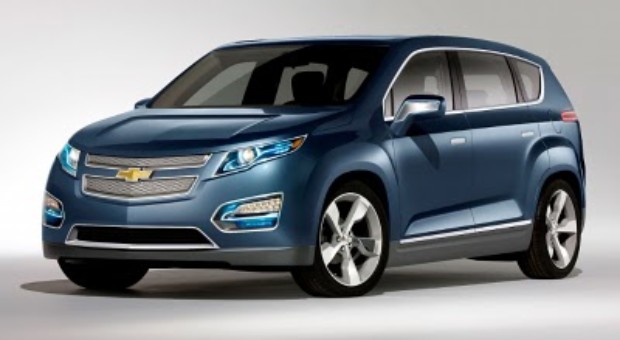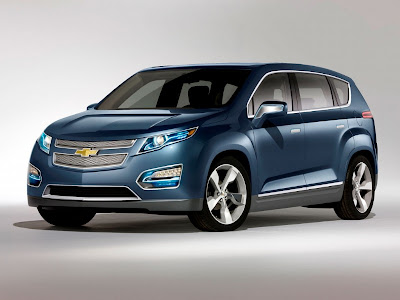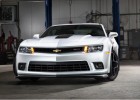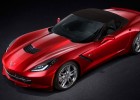
Chevrolet Volt MPV5
The styling of the Chevrolet Volt MPV5 concept borrows design and aerodynamic cues from the Chevrolet Volt.
The front fascia is among the most aerodynamic of any crossover thanks to its closed grille and aero-optimized lower air dam, both of which help improve fuel efficiency.
A full-underbody belly pan, along with rocker claddings, creased tail lamps and specially designed blades on the rear quarter, also help the Chevrolet Volt MPV5 concept cut through the wind with ease. The intense focus on improved aerodynamics enables greater all-electric range.
The exterior of the Chevrolet Volt MPV5 concept isn’t solely about efficiency. Its Sonic Blue Metallic paint provides a contemporary appeal, while the dual skylight panels and 19-inch Volt-inspired wheels build the Chevy Volt MPV5 concept’s sporty credentials.
The Chevrolet Volt MPV5 concept’s dimensions provide added passenger comfort. While the 2,760-mm wheelbase of the Volt MPV5 concept is a mere 15 mm longer than the wheelbase of the Chevrolet Volt, its body is 181 mm longer (4,585 mm), 73 mm wider (1,871 mm) and 182 mm taller (1,612 mm) than the Volt.
Inside, the Chevrolet Volt MPV5 concept adopts the Volt’s center stack and gauge cluster along with its striking two-tone leather seats. Thanks to the Chevrolet Volt MPV5 concept’s size, passenger comfort doesn’t take a backseat.
Typical for Chevrolet crossovers, the Volt MPV5 concept’s seating position allows for maximum comfort and flexibility, including improved entry and egress.
When it comes to cargo, the Chevrolet Volt MPV5 concept carries on the crossover tradition thanks to its flip-and-fold second row seating, which provides up to 1,764.1 liters of cargo space with the seats folded and 863.7 liters of space behind the second row.
The Chevrolet Volt MPV5 concept utilizes the same Voltec propulsion system found in the Chevrolet Volt, including the added capability of an engine generator to extend the driving range and eliminate “range anxiety.” A 16-kWh T-shaped lithium-ion battery pack powers the electric drive unit.
The flexibility of the Voltec system enables the Chevy Volt MPV5 concept to meet full vehicle speed and acceleration requirements while driving the vehicle and its five occupants up to 51.5 km on pure electric propulsion. This is double what the average urban commuter in China travels each day. When the battery is depleted, a 1.4-liter engine generator sustains the battery charge and provides up to 482 km of electric propulsion.
GM continues to advance electrification in China through research and development. It has launched the China Automotive Energy Research Center (CAERC) in Beijing. The venture with SAIC and Tsinghua University is developing a comprehensive automotive energy strategy for China.
The GM China Science Lab, which opened last November, is carrying out advanced automotive-related research, including battery development. In March, GM introduced the EN-V (Electric Networked-Vehicle) concepts in Shanghai.
A centerpiece of the SAIC-GM Pavilion at World Expo 2010 Shanghai, EN-V embodies GM’s vision for personal urban mobility in 2030. In addition, GM is supporting its Shanghai GM joint venture’s “Drive to Green” strategy, which is focused on developing green products, supporting green manufacturing and undertaking a green responsibility.
While Chrysler has failed to find a way to update or replace the retro-styled PT Cruiser, we can definitely see this as a forthcoming replacement to the Chevrolet HHR. The Volt MPV5 is slightly larger than HHR, but fills a similar market niche.
While Chevrolet hasn’t announced a firm production commitment, it wouldn’t be surprising to see the MPV5 built in both conventional and ER-EV forms to help jack up GM’s light truck CAFE numbers.
The roomy interior will likely find a bigger audience than the smaller Volt while still yielding a 32 mile electric range, and if we had to guess, we’d see the Orlando-inspired plug-in EV hit the market by 2013.
2010 Chevrolet Volt MPV5 Concept (2010 Beijing Auto Show)
Credit foto: Autowereld, Holland






















